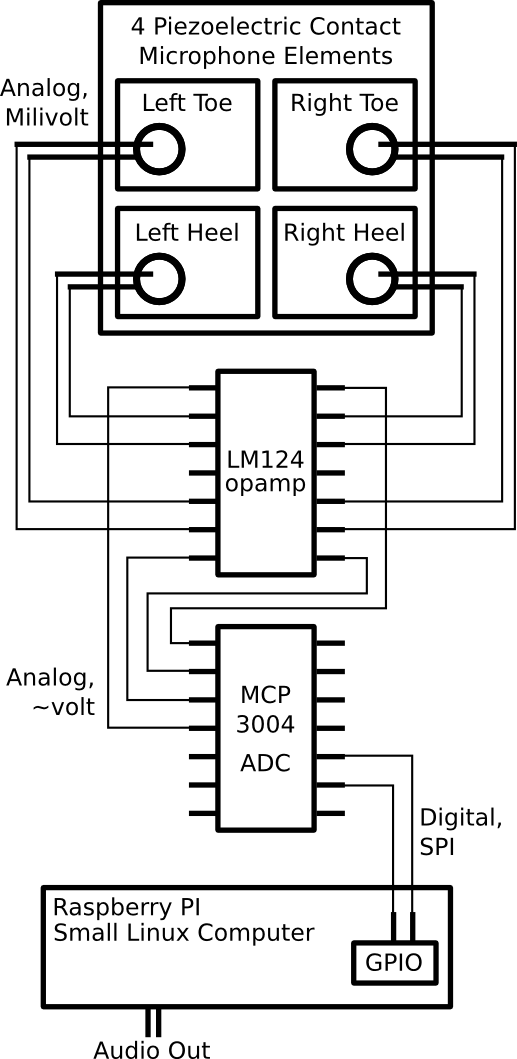Designing a MIDI Footboard |
October 15th, 2013 |
| footboard, music |
If you put on standard dress shoes and tap on the stage, you're limited to how that particular combination happens to sound. Maybe you get a carpeted stage, or your shoes are kind of thuddy. Better is to experiment with a bunch of combinations of boards and shoes until you have a pair you like, and then bring them to every gig. If you mic this it will usually work well, but can have issues with resonant stages or noisy rooms.
Alternatively, you can use a contact microphone, embedded in a board. This is much less prone to interference from other sounds on stage. I made one of these about three years ago. If you do this, though, you need to make sure you're attaching it to something with a very high input impedance, in the 1MΩ range. If you attach it to something more standard, at 50KΩ or 10KΩ you're making a kind of kind of high-pass filter which removes low frequency sounds. Shoes on wood are already somewhat clicky, and this makes it worse.
While I could work around all of these, what I'm not going to be able to get is real flexibility. Sometimes I'd like to have the sound of feet on wood, but other times a kick-drum and snare would be more suitable. [1] What if we go electronic?
While no one wants to listen to a midi fiddle, drum sounds are some of the ones we can best generate electronically. Unfortunately I can't find any midi controllers designed for playing drums with your feet. Could I make one? Here's a design I've been playing with:

(This only shows the signal connections.)
The idea is that there would be a footboard with four different regions, each with a little piezo contact mic. This signal needs to get into the Raspberry PI which can synthesize the drum sounds, but that only has digital inputs, so we can use an MCP3004 analog to digital converter to bridge the gap. Unfortunately while the piezos generate a strong signal as microphones go, they're much less than what electronics would normally expect, so we need to amplify them. The LM124 is a four channel opamp which looks like it can take the millivolt level output of the piezos up to the volt levels the analog to digital converter can process.
I haven't tried any of this yet, or even ordered the parts. Before I do, is there anything I'm overlooking?
Update 2013-11-05: After talking about designs with people I've realized that this would be a pretty ambitious hardware project, and would be a lot of work for something I'm not yet sure I would like. So instead I bought a used Yamaha DTX500 drum trigger module ($165 on ebay) which takes weak electrical signals as inputs and uses those to trigger drum sounds. It's designed to be used as the core of an electronic drum kit, but should work with simple piezoelectric contact mics. I tested it with my old footboard and it does work, so now I need to wait for the rest of my pickups to arrive.
[1] And equally traditional. Looking at old
pictures of contra dances in the first half of the 20th century
drum kits were pretty standard.
Comment via: google plus, facebook, substack